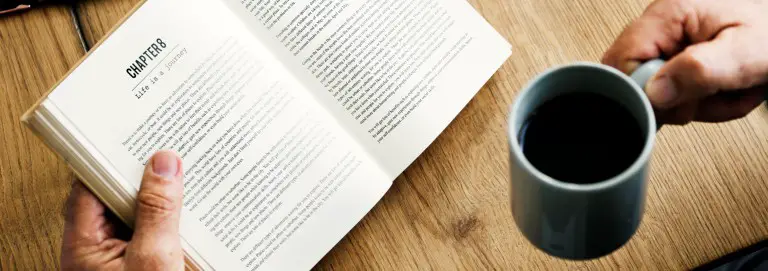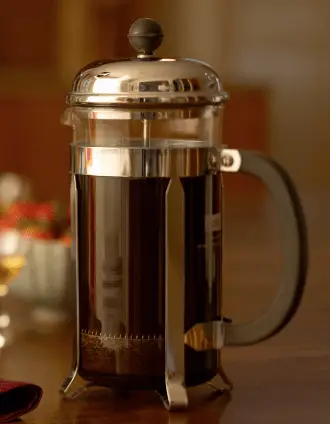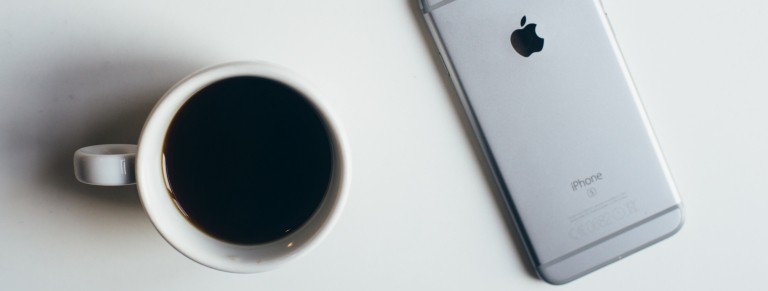Have you even wondered what the difference between French press and drip coffee is anyways? There are lots of people that swear by French press coffee – they make it seem so trendy and cool that you think you should just drink your coffee from a press pot every time.
If you have been a long time user of drip coffee you are probably curious what all the fuss is about and wondering if there is anything to this at all.
Well, here at the TOMC we don’t care a whole lot about what brewing method you prefer. We just want you to find a brewing method or two that you love to make and drink.
For some people, no coffee will be better the regular coffee from a standard coffee maker, but for those that enjoy the process there is a lot of flavor you can get out of coffee beans with a French press that you may not be able to get out so easily with a drip machine.
Shall we explore the differences in greater depth?
The Main Differences Between French Press and Regular Drip Coffee

Before we look closely at either of these two methods, I want to first explain to you the main differences between French press coffee and regular drip coffee.

- French Press coffee preserves the coffee oils in your cup, which add to the aromatics and enhance the flavor.
- French press coffee leaves you with a coffee that has some texture to it. The smallest of grind particles enter your cup through the fine mesh plunger, leaving you with a coffee that feels full bodied and tastes full bodied.
- The larger your press pot is the better flavor you will usually get out of your grind due to the higher the water temperature stays during the brewing period. You can see my favorite big French presses here.
- French press coffee requires specially ground beans. Your beans must be ground coarsely and consistently to keep the coffee clean enough to drink from, enjoyably. Most people need to buy their own grinder for the French press because pre-ground coarse coffee can be hard to find in stores and grocery store grinders can be hit or miss. While we recommend people on a tight budget pick up a manual grinder for the French press, the best option is to pick up a good-quality, electric, burr grinder like the Baratza Virtuoso or the lower priced Breville Smart Grinder Pro, which are both excellent at making grind perfect for a French press.
- The French press demands more babysitting – you need to actually manually do every step and timing is important. Conversely, an automatic drip coffee maker will heat the water, brew the coffee, and even turn itself off after a couple hours for you. It’s much easier to work, passively.
So, to summarize, French press coffee provides a lot of potential for great flavor and drink texture, but only if you have the patience to grind your own beans and make it every morning…and also only if you are ok with a little “body” in your cup.
There are some dual-filter French press pots that are better at filtering out the grind from your coffee than the single screen version, but you’ll have to spend a bit more to get one. The best is probably this one by Frieling, or the more affordable Espro Press P5, which utilizes a really fancy screen to eliminate nearly all sediment from getting into your cup.
Is French Press Better Than Regular Coffee?

The simplest answer to this is yes – it is a lot better than regular drip coffee because it doesn’t filter away all the good coffee oils that you should want in your cup.
The oils from a good cup of coffee are like frosting on a cake, garlic in pasta, or like cinnamon on a roll. We cook with aromatics because they add subtle flavor to our food to take it to the next level and without them our coffee it is simply missing something special.
The main reason to make coffee from any device that doesn’t use a paper filter is to get these oils. Moka pots, espresso, percolators, and French presses all preserve the oils in the coffee and are all fundamentally better than drip coffee, or any other method that filters your coffee through paper.
Now, having said that, we understand that not everyone is able to buy a really expensive grinder and a fancy French press to get the full experience. We also know that the benefit of making top shelf French press coffee may not be worth the hassle every morning. It takes time and effort in the kitchen to brew French press coffee, which is why we expect even coffee snobs to make drip coffee from time to time.
However, there is a lot you can do to get great coffee from an automatic machine, too, which we will now cover below.
Related – See my favorite single cup french presses here.
Is Drip Coffee Better Than French Press?

The answer to this is a resounding no. Automatic drip coffee (even from the best machine) is not as good as properly prepared French press coffee, but it is easier to make, for sure. You can even make it really well if you really want to.
Drip coffee makers on the high end can cost a lot of money, more so than even the most expensive French press pots, but to make the best possible coffee in them you still have to add a bit of a manual touch to your routine.
Although you don’t have to worry about buying a good grinder for coarse grounds, you still should own one anyway, because the freshness of the grind makes a big difference in the flavor of the coffee, even in a regular coffee maker. Grinding your beans minutes before brewing them makes a noticeable difference to even the average tongue.
Using filtered water can make a difference, too, as can preheating your coffee maker’s heating element, but that is fodder for another post.
Long story short, around here we believe that drip coffee has its place. Goodness, even I have a drip coffee maker on my countertop that I use it from time to time. We also believe that your automatic coffee maker shouldn’t be an all-in-one device either. Let your grinder be a stand alone device for goodness sake, all of the best coffee grinders are stand alone, anyway, and they can get you fresh grounds for all of your brewers too.
A favorite countertop drip coffee maker of mine is the BUNN GRB Velocity Brew, which does everything it can to give you great coffee despite the lack of oils. As an added perk, it’s probably the fastest possible way to getting a cup of coffee on-demand, save for owning a single serve pod coffee maker.
Which One is Best?

By now it should be clear. At the Gamble Bay Coffee Company we believe the best coffee isn’t filtered through paper. Great coffee should preserve the natural oils that are both present and desirable in freshly ground coffee beans.
If you are thinking about getting your first ever French press then we wholeheartedly support you on that. There are, of course, a ton of inexpensive French presses out there to choose from, Bodum is well known, a best seller, and they make a number of French presses that are dishwasher safe but we do recommend you pick up a higher quality, insulated French press because they will make better coffee due to their better temperature regulation.
The best of the best is the Frieling or the Espro Vacuum Insulated Press, but any insulated model will do so long as you transfer your finished brew to a stand alone carafe after brewing. Again, though, that is fodder for another post.
French Press Vs Drip Coffee: What’s The Difference?

We’ve all had that moment, whether it was before a big interview, after a long a long night with a teething baby or hopping off a red eye flight, the moment of desperately reaching for cup of coffee.
Sometimes every sip is like a hug for your tired body and mind, but other times it’s a bitter disappointment.
Have you wondered why?
Here’s the deal:
There are many things to take into account from beans and roast to equipment and flavors. But the brewing method is the most pivotal part of the process of a great cup of Joe.
Now, we realize that everyone is different. Our taste preferences, our schedules and our budget all affect how we handle our daily caffeine routine. So, we at Gathering Grounds have put together a little how-to so that you can have the perfect cuppa every time.
Before we get into that however it’s important that you are using great beans, fresh grind, and good equipment. We prefer using insulated french presses and SCAA certified coffee makers because they make better coffee than their cheaper counterparts.
The insulated Espropress is probably the best french press around and when stacked up against the Technivorm Moccamaster then you’ve got a good competitive environment!
Let’s talk about brewing with both the French Press and the drip coffee maker step by step, so you can choose what’s right for you.
The tried and true French press
 With this brewing system, you are engaged the entire process of your morning pick-me-up.
With this brewing system, you are engaged the entire process of your morning pick-me-up.
Step 1: you put the water on.
Whether you have a whistling tea pot or it’s modern counterpart, the electric kettle, do not let the water come to a boil. As we all know, the boiling point for water is 212° F, and that is simply too hot. Scalding water results in that bitter, sour taste we have all encountered. The National Coffee Association (NCA) has deemed 195-205 ° F the sweet spot for a flawless extraction of the flavour notes in your particular blend.
While the water is warming, you can turn your attention to step 2: grinding and measuring the beans.
Portland based coffee company, Stumptown Coffee Roasters, likens the perfect texture of coarsely ground coffee to that of bread crumbs. This is important because the coarseness of the bean will allow more of the oils to be extracted, which leads to the dark, rich taste that is associated with French pressed coffee.
The NCA suggests that the perfect coffee to water ratio is 2 TBSP per 6 fl. oz. Obviously, the more you add, the stronger your press will be.
Once your grounds are in the press, and your water is warmed, you’re ready for step 3: pour.
There are two schools of thought when it comes to the proper way to brew a French press.
One suggests that you must first fill the cylinder halfway. The prominent equipment supplier, Cliff and Pebble, tells us that this is an important step in the intensity of flavour.
The other side suggests that allowing for a longer steep will do the trick.
If you decide to go with the first method, you would follow step 4 and then fill the rest of the press before proceeding to step 5.
Step 4: Breaking the Crust
“Breaking the crust” is barista speak for stirring the grounds that have floated to the top of the cylinder. This “breaking” is an essential part of the brewing process because it loosens the grounds so that the water will be better infused during the next step.
Step 5: and we wait.
The NCA says that the brew time for a French press anywhere from 2-4 minutes. This time correlates with your preference to darker or lighter taste.
The 6th and final step: put the press in French press.
Bear down on the plunger at a slow and consistent pace.
Then pour and enjoy the fruits of your labour.
Coffee connoisseurs around the world favor this method because it requires intentionality. It creates a daily 5-7 minute ritual, on top of being easy to clean and store.
If you are a fan of the French press you may also like the Chemex for a similar ritual in the morning but with a filtered taste.
Bestselling French Press Coffee Makers
Here are a few of the best selling french presses today. Some are on here due to their low price so don’t expect them all to be literally “the best”.
–This section is being updated–
Let’s move on. What’s the drip on drip coffee?
This is the most convenient way to make coffee, if you have the counter space to spare, and don’t have the time to give to a French press.
 If you were to walk down an the kitchen appliance aisle at any store, you would surely bump into an array of coffee machines ranging from single cup Keurigs to on demand coffee dispensers. The classic Mr. Coffee drip coffee maker is a perfect example of a standard drip coffee rig.
If you were to walk down an the kitchen appliance aisle at any store, you would surely bump into an array of coffee machines ranging from single cup Keurigs to on demand coffee dispensers. The classic Mr. Coffee drip coffee maker is a perfect example of a standard drip coffee rig.
With these, getting your fix is easy. Some have timers that you can set, so you don’t have your coffee at the exact same time every day. It even boils your water for you. It’s as simple as:
Step 1: Fill reservior with water.
Any coffee expert will warn you that it is absolutely imperative to use filtered water when you are making coffee in a machine.
Tap water as too many minerals in it, and causes calcification/ build up, which will ruin the quality of brew you get in the end.
On the other hand, using distilled water may cause your coffee to taste bland or flat.
A simple Brita filter will make all the difference.
Step 2: measuring ground into filter
We all have that one uncle who makes his coffee so strong, it looks like motor oil. In order to avoid that burnt taste and grimy mouth feel, you can follow the NCA’s suggested 2 TBSP to 6 fl. oz. rule.
Lay your filter into the brew basket, and fill grounds evenly.
If you have a Keurig this part is even easier.
Just peel the sticker off the back of the pod, place that into the cup holder, and press the cup into the needle.
Step 3: Wait for water to boil
Baristas in higher end coffee shops, will typically offer you a pour over, if you ask for a drip. Where the mechanics are essentially the same, with a pour over you can ensure that the water temperature to stay within that 195°F-205°F With a machine, you’re trusting the temperature gauge to be accurate.
Step 4: let out your inner child and, push the button!
It’s like magic; it really is. You can hop in the shower, finish an essay, or walk the dog and there will be coffee waiting for you.
So what’s the bottom line?
French pressed and drip coffee are very different.
French presses yield a fuller flavor, because the oils have not been filtered out. But it takes longer.
Drip coffee is easy and it’s consistent. But it usually yields lighter brews.
If you like the unfiltered taste of the French press but don’t like the time involved then maybe look at the the Aeropress as an alternative.
Which is better?
That’s up to you.
We have an assortment of coffee makers available here. We’d love to hear about your experiences with the different types in the reviews.
